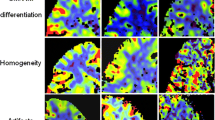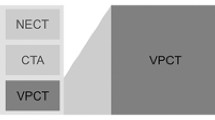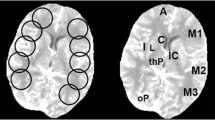Abstract
Objectives
To investigate the feasibility of 70 kV cerebral CT perfusion by comparing image quality and radiation exposure to 80 kV.
Methods
Thirty patients with suspected cerebral ischemia who underwent dual-source CT perfusion were divided into group A (80 kV, 150 mAs) and group B (70 kV, 150 mAs). Quantitative comparisons were used for maximum enhancement, signal-to-noise index (SNI), and values of cerebral blood flow (CBF), cerebral blood flow (CBV), mean transit time (MTT) on CBF, CBV, and MTT images, and radiation dose from these two groups. Qualitative perfusion images were assessed by two readers.
Results
Maximum enhancement for group B was higher than group A (P < 0.05). There were no significant differences between the two groups for SNI on CBF and CBV maps (P = 0.06 – 0.576), but significant differences for MTT when SNI was measured on frontal white matter and temporo-occipital white matter (P < 0.05). There were no differences among values of CBF, CBV, and MTT for both groups (P = 0.251–0.917). Mean image quality score in group B was higher than group A for CBF (P < 0.05), but no differences for CBV (P = 0.542) and MTT (P = 0.962). Radiation dose for group B decreased compared with group A.
Conclusions
70 kV cerebral CT perfusion reduces radiation dose without compromising image quality.
Key Points
• Radiation dose is a key concern with the increased using cerebral CT perfusion. Cerebral CT perfusion of 70 kV reduces radiation dose without compromising image quality.
• A 70-kV protocol could be used for cerebral CT perfusion.




Similar content being viewed by others
References
Juluru K, Shih JC, Raj A et al (2013) Effects of increased image noise on image quality and quantitative interpretation in brain CT perfusion. AJNR Am J Neuroradiol 34:1506–1512
Koenig M, Kraus M, Theek C, Klotz E, Gehlen W, Heuser L (2001) Quantitative assessment of the ischemic brain by means of perfusion related parameters derived from perfusion CT. Stroke 32:431–437
Wintermark M, Reichhart M, Thiran JP et al (2002) Prognostic accuracy of cerebral blood flow measurements by perfusion computed tomography, at the time of emergency room admission, in acute stroke patients. Ann Neurol 51:417–432
Wintermark M (2005) Brain perfusion-CT in acute stroke patients. Eur Radiol 15:D28–D31
Eastwood JD, Lev MH, Azhari T et al (2002) CT perfusion scanning with deconvolution analysis: pilot study in patients with acute middle cerebral artery stroke. Radiology 222:227–236
Koenig M, Klotz E, Luka B, Venderink DJ, Spittler JF, Heuser L (1998) Perfusion CT of the brain: diagnostic approach for early detection of ischemic stroke. Radiology 209:85–93
Gillard JH, Antoun NM, Burnet NG, Pickard JD (2001) Reproducibility of quantitative CT perfusion imaging. Br J Radiol 74:552–555
Hoang JK, Wang C, Frush DP et al (2013) Estimation of radiation exposure for brain perfusion CT: standard protocol compared with deviations in protocol. AJR Am J Roentgenol 201:W730–W734
United States Food and Drug Administration website. Safety investigation of CT brain perfusion scans: update 11/9/2010. www.fda.gov/medicaldevicesmedicaldevices/safety/alertsandnotices/ucm185898.htm. Accessed 5 July 2013
Brenner DJ, Hall EJ (2007) Computed tomography–an increasing source of radiation exposure. N Engl J Med 357:2277–2284
Niesten JM, van der Schaaf IC, Riordan AJ et al (2014) Radiation dose reduction in cerebral CT perfusion imaging using iterative reconstruction. Eur Radiol 24:484–493
American Association of Physicists in Medicine website (2012) Adult brain perfusion CT protocols version 1.1. www.aapm.org/pubs/CTProtocols/documents/Adult/Brain/PerfusionCT.pdf. Accessed 5 July 2013
König M, Bültmann E, Bode-Schnurbus L, Koenen D, Mielke E, Heuser L (2007) Image quality in CT perfusion imaging of the brain. The role of iodine concentration. Eur Radiol 17:39–47
Bodelle B, Klement D, Kerl JM et al (2013) 70 kV computed tomography of the thorax: valence for computer-assisted nodule evaluation and radiation dose - first clinical results. Acta Radiol 22
Wintermark M, Maeder P, Thiran JP et al (2001) Quantitative assessment of regional cerebral blood flows by perfusion CT studies at low injection rates: a critical review of the underlying theoretical models. Eur Radiol 11:1220–1230
Kang KH, Kim HS, Kim SY (2008) Quantitative cerebrovascular reserve measured by acetazolamide-challenged dynamic ct perfusion in ischemic adult Moyamoya disease: initial experience with angiographic correlation. AJNR Am J Neuroradiol 29:1487–1493
Axel L (1983) Tissue mean transit time from dynamic computed tomography by a simple deconvolution technique. Investig Radiol 8:94–99
Tawfik AM, Kerl JM, Razek AA et al (2011) Image quality and radiation dose of dual-energy CT of the head and neck compared with a standard 120-kV acquisition. AJNR Am J Neuroradiol 32:1994–1999
Wintermark M, Maeder P, Verdun FR et al (2000) Using 80 kV versus 120 kV in perfusion CT measurement of regional cerebral blood flow. AJNR Am J Neuroradiol 21:1881–1884
Tracers. In: Miles K, Dawson P, Blomley M (eds) Functional computed tomography. ISIS Medical Media, Oxford pp 29–45
Koenig M, Bueltmann E, Hering von Diepenbroick V, Koenen D, Heuser L (2001) Increase of contrast signal by means of low-tube voltage in CT perfusion imaging of the brain. Radiology 221:346
Zhang J, Wang J, Geng D, Li Y, Song D, Gu Y (2013) Whole-brain CT perfusion and CT angiography assessment of Moyamoya disease before and after surgical revascularization: preliminary study with 256-Slice CT. PLoS ONE 8:e57595
Cohnen M, Wittsack HJ, Assadi S et al (2006) Radiation exposure of patients in comprehensive computed tomography of the head in acute stroke. AJNR Am J Neuroradiol 27:1741–1745
Sakamoto S, Ohba S, Shibukawa M, Kiura Y, Arita K, Kurisu K (2006) CT perfusion imaging for childhood moyamoya disease before and after surgical revascularization. Acta Neurochir (Wien) 148:77–81
Hoeffner EG, Case I, Jain R et al (2004) Cerebral perfusion CT: technique and clinical applications. Radiology 231:632–644
Frey GD, Rumboldt Z (2005) Radiation effects from perfusion CT. Radiology 234:638, author reply 638
Krissak R, Mistretta CA, Henzler T et al (2011) Noise reduction and image quality improvement of low dose and ultra low dose brain perfusion CT by HYPR-LR processing. PLoS ONE 6:e17098
Acknowledgement
The authors acknowledge Xiaohui Zhang and Fu-Fu Chen from Siemens Healthcare for their great support.
The scientific guarantor of this publication is Bin Song. The authors of this manuscript declare no relationships with any companies, whose products or services may be related to the subject matter of the article. The authors state that this work has not received any funding. Hang Li kindly provided statistical advice for this manuscript. Institutional Review Board approval was obtained. Written informed consent was obtained from all subjects (patients) in this study. Methodology: prospective, diagnostic or prognostic study, performed at one institution.
Author information
Authors and Affiliations
Corresponding author
Additional information
Hang Li and Kai Zhang contributed equally to this work.
Rights and permissions
About this article
Cite this article
Li, Zl., Li, H., Zhang, K. et al. Improvement of image quality and radiation dose of CT perfusion of the brain by means of low-tube voltage (70 KV). Eur Radiol 24, 1906–1913 (2014). https://doi.org/10.1007/s00330-014-3247-1
Received:
Revised:
Accepted:
Published:
Issue Date:
DOI: https://doi.org/10.1007/s00330-014-3247-1




